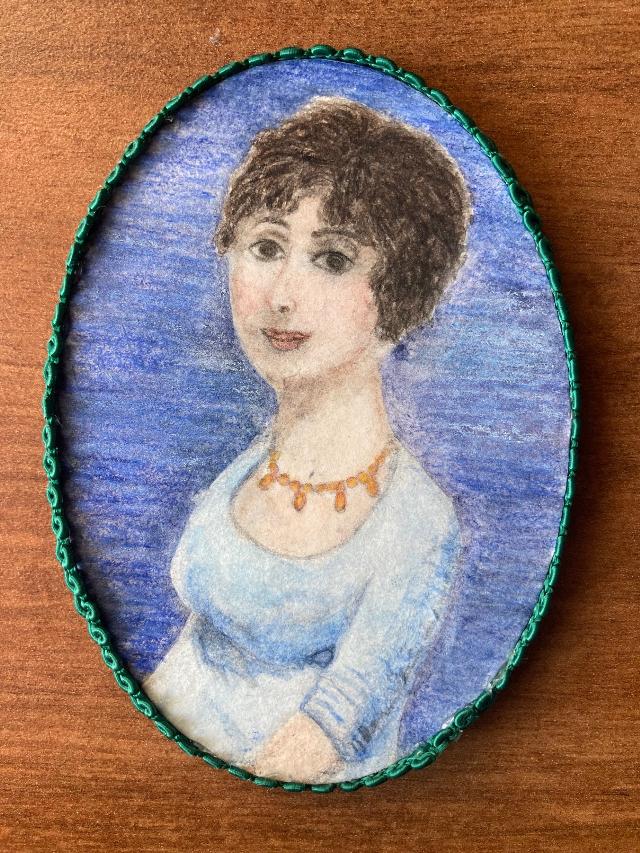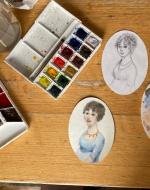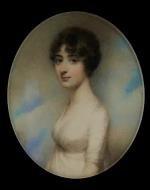Created by Kira Molnar on Wed, 10/18/2023 - 00:22
Description:
For my COVE case, I am attempting to recreate William Wood's portrait of Mary Pearson, who became known to the Austen family through her engagement to Jane's brother Henry Austen. The pair met in the summer of 1796 at Rowling and Kent (where Jane's elder brother Edward lived with wife Elizabeth). Jane, at this point in time, was in the beginning stages of writing her second novel, First Impressions, later to be renamed Pride and Prejudice (1813). The engagement between Henry Austen and Mary Pearson was short-lived and was broken off by Henry just a few short months later. Soon after ending this relationship, Henry got engaged to his widowed cousin Eliza Hancock, and the two married the following year in December 1797. Eliza had her own rather pointed evaluation of Mary, describing her as "a pretty wicked looking girl, with bright black eyes which pierce through and through." Mary Pearson and Jane Austen continued to stay in contact with one another until 1799, during which time Mary gave Jane all of the letters she and Henry had written to one another during their engagement period. In view of Jane Austen becoming acquainted with Mary Pearson around the same time she began writing what would later become her most prized and beloved novel, it is widely thought that Jane used Mary as a model for Lydia Bennet, Pride and Prejudice's most infamous high-spirited and headstrong Bennet sister. Although Mary Pearson may have acted as the very first influence for Lydia Bennet, Lydia's character continues to live on through the ever expanding collections of fiction, media, and art, showing us that the characters we love (or perhaps in Lydia's case — the characters we find entertaining) never truly leave us.
Watercolor Portrait Miniature of Mary Pearson, Model for Lydia Bennet, 4.25" x 3", by Kira Molnar, 2023. My finished recreation of William Wood's portrait of Mary Pearson showcases her in a blue Regency style dress and a topaz colored necklace. I opted to add a darker blue/purple background, beginning first with watercolor, and then going over it a second time with colored pencils for a more shiny, textured surface. Only the background received the added layer of colored pencil, while the main figure of Mary Pearson remains solely watercolor. I finished off my project by mod podging my finished painting onto my prepared wooden oval, before finally hot gluing an emerald green braided cord with scalloped edges to frame my portrait miniature.
Crafting Process of Mary Pearson Portrait Miniature, Model for Lydia Bennet, by Kira Molnar, 2023. Using the 4.25" x 3" wooden oval cut out in the Skidmore's IdeaLab for size reference, I began my project by cutting out the same sized shape from regular printer paper. I started by making a rough sketch in pencil first, to get the general idea for proportions, before moving on to the more durable watercolor paper that I would use for my final version of the portrait. After redrawing the portrait a second time on the new paper, I then moved into adding the watercolor paints. I knew early on that there were some alterations I wanted to make from William Wood's original portrait, and I began this process by changing the shape and color of the dress as well as adding a necklace. I had felt that in the original, the color of the dress blended into the color of Mary Pearson's skin, and therefore I decided to opt for a more traditional Regency blue for my recreation.
William Wood, Watercolor Portrait Miniature of Mary Pearson, circa 1796, Part of Jane Austen's House Museum Collection, Wikimedia Commons. This watercolor portrait miniature, painted by William Wood in 1796, is the only known portrait of Mary Pearson, and it is believed to have been used by Mary for her return to society, a way to put herself back out on the marriage market, and find a potential suitor. Unfortunately for Mary, it wouldn't be until nearly two decades later — now at an age in which, during the Regency era, society would have long tossed her aside and labeled her as an "old maid" — that she would finally find her match. She married Richard Higginson, an officer of the Royal Marines, in 1815. Like Mary Pearson, Lydia Bennet quickly falls for a militia officer — though Lydia, unlike Mary, is able to latch on to her fiancé only after some bribery from Mr. Darcy; bribed, Mr. Wickham agrees to tie the knot and marry Lydia.
C.E. Brock, "She Went after Dinner to Show Her Ring, and Boast of Being Married, to Mrs. Hill and the Two Housemaids," 1895, for Pride and Prejudice (1813), by Jane Austen, Volume III, Chapter IX, Wikimedia Commons. Lydia Bennet is the most headstrong, careless, highly opinionated, and prideful Bennet sister. She follows her own heart and desires without thinking twice about the after effects that her actions have on those around her and is quick to voice her opinions and beliefs. Lydia's immaturity can in large part be attributed to her age, as she is the youngest of the sisters, starting the novel at just fifteen years old. Age matters not to Mrs. Bennet, whose primary drive is to see all her daughters married off; as a result, Lydia is permitted with the rest of her sisters to enter society and attend the various balls and social events. Lydia's charming and flirtatious character eventually catches the attention of Mr. Wickham, and her reckless nature, defying society's strict social rules, gets the better of her as she decides to run away with Wickham. The scandal is great, for Mr. Wickham refuses to marry Lydia, seeing her only as a temporary fling and having no genuine feelings of remorse on how his refusal to marry would ruin both Lydia and her entire family. It is not until Mr. Darcy steps in — offering to pay off all of Mr. Wickham's debts as well as buy him the position of a commissioned officer in the army — that Wickham agrees to follow through with a proposal and marry Lydia. Scandal averted, Lydia — as Charles Brock depicts her — returns home newly married and visits with her family, during which time she gleefully presents her ring to all who will take notice and pay her attention.





